The Lights of Cobb and Co: Coaching between Brisbane and Gympie in the 1860s.
By Christina Ealing-Godbold, Research Librarian | 20 January 2023
“Cobb and Co: a Retrospective of Coaching in Australia”. by William Lees. 192?. John Oxley Library, State Library of Queensland.
Transport defined so many aspects of the development of early Queensland and the lives of early residents. The coaching trade was key to the overland routes, prior to the development of railways and air transport. However, the key to the coach routes was passable roads. Roads were poor, particularly in coastal areas where rivers, streams and ravines were common in the landscape.
The discovery of gold in Gympie in 1867 caused the inevitable rush to find fortunes. However, the road was impassable in many places, going through Woodford and over the Stanley range. Many drays laden with goods found themselves at the bottom of a gully. A new route, also problematic in places was established in 1868. The new road went via Caboolture, Glasshouse Mountains and Yandina. Tales of the horrors of the road to Gympie filled the newspapers of the day.
In August 1868, William Henry Walsh wrote in a letter to the Ipswich and General Advertiser:
...my experience of three days climbing and plunging and sliding along compels me to say that as a whole and in parts, it is the worst line of road I ever saw.
Traveller Anthony Trollope in his published recollections echoed the opinion of Mr Walsh –
There is often no road and the coach is taken at random through the forest… But the great miracle is the sudden pinches, looking as if they were almost perpendicular, down which the coach is taken – and then the equally sharp ascents – not straight, but at a sharp angle, up and around which the coach is whirled.
Deputations, delegations and parliamentary debates were filled with the problem of what to do about the road. Money was found, but in August 1868, Mr Bennett, the Queensland Manager of Cobb and Co after taking the journey to Gympie told the Government that there was no way he would travel on the road, saying that it was a little way off before the road would be ready. When asked if he could use a lighter coach over the difficult road, Mr Bennett replied that he could do that. Cobb and Co, established in 1853 in Victoria, imported Concord Coaches, with better springs and lighter in build than the traditional rigid English road coach. Concord Coaches used leather straps as braces to allow more flexible movement on rough roads. Cobb and Co also manufactured their own coaches in Australia from the 1860s, purpose built for Australian conditions.
Mr Alder, the Engineer for the Gympie Road reported in August of 1868 that there were still numerous creeks to make passable – two near Caboolture and portions of the road between Mr Lander (Landers Shute) and Mooloolah Creek Mr Alder refers to the trees as mile markers – the route had been mapped out by Cobb and Co drivers simply marking the trees – a rough form of surveying indeed.!
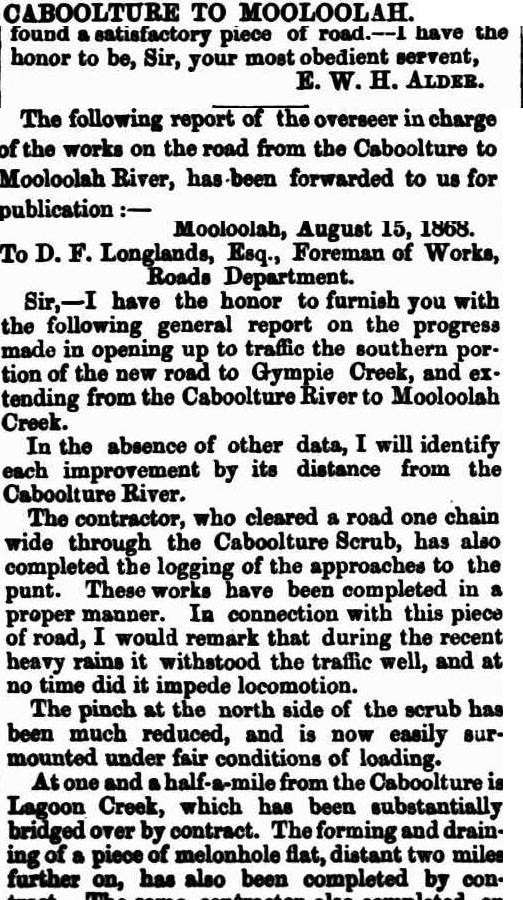
Caboolture to Mooloola. The Queenslander (Brisbane, Qld. : 1866 - 1939) 22 August 1868: 9. Trove, National Library.
By November 1868, it was decided that suitable coaches had been found and some improvements to the road had been made. Hence, the first service commenced, running twice a week from Brisbane to Gympie. For the coach companies, the key to economic viability was the Government mail contracts. Cobb and Co won the contracts because they were the fastest coaches on the road and had an extensive network. The speed of the Cobb and Co coaches was founded on several factors: lighter coaches, fast changing station procedures, quick refreshment stops and expert drivers who were fearless in their driving and expert in their knowledge of the road. At the changing stations (every 30 miles or so), there was a team of horses controlled by a groom. Each groom looked after a small number of horses, and used standard fittings for each horse and coach, to maximise speed at the change-over. The coach driver sounded a bugle one mile out from the changing station so that all was ready.
With their expertise in adapting American coaches to Australian conditions, Cobb and Co manufactured their own vehicles in Queensland, and opened an extensive factory in Charleville. A catalogue of their vehicles is available in the John Oxley Library.
Cobb and Co. Passenger Coach used on the Cobb and Co Mail Service runs. Cobb and Co Coach Catalogue of High Class Vehicles. John Oxley Library, State Library of Queensland.
Changing stations were needed, with sufficient stables for the horse teams, and rooms and refreshments for grooms and drivers as well as passengers. In Gympie, the stables were adjacent to the Northumberland Hotel in Channon Street. Cobbs Camp at Woombye and Bankfoot House in the Glass House Mountains were key changing stations on the Brisbane to Gympie route. The Caboolture station was named “The Punt” as it was necessary for coach and horses to be loaded onto the punt or ferry to cross the river.
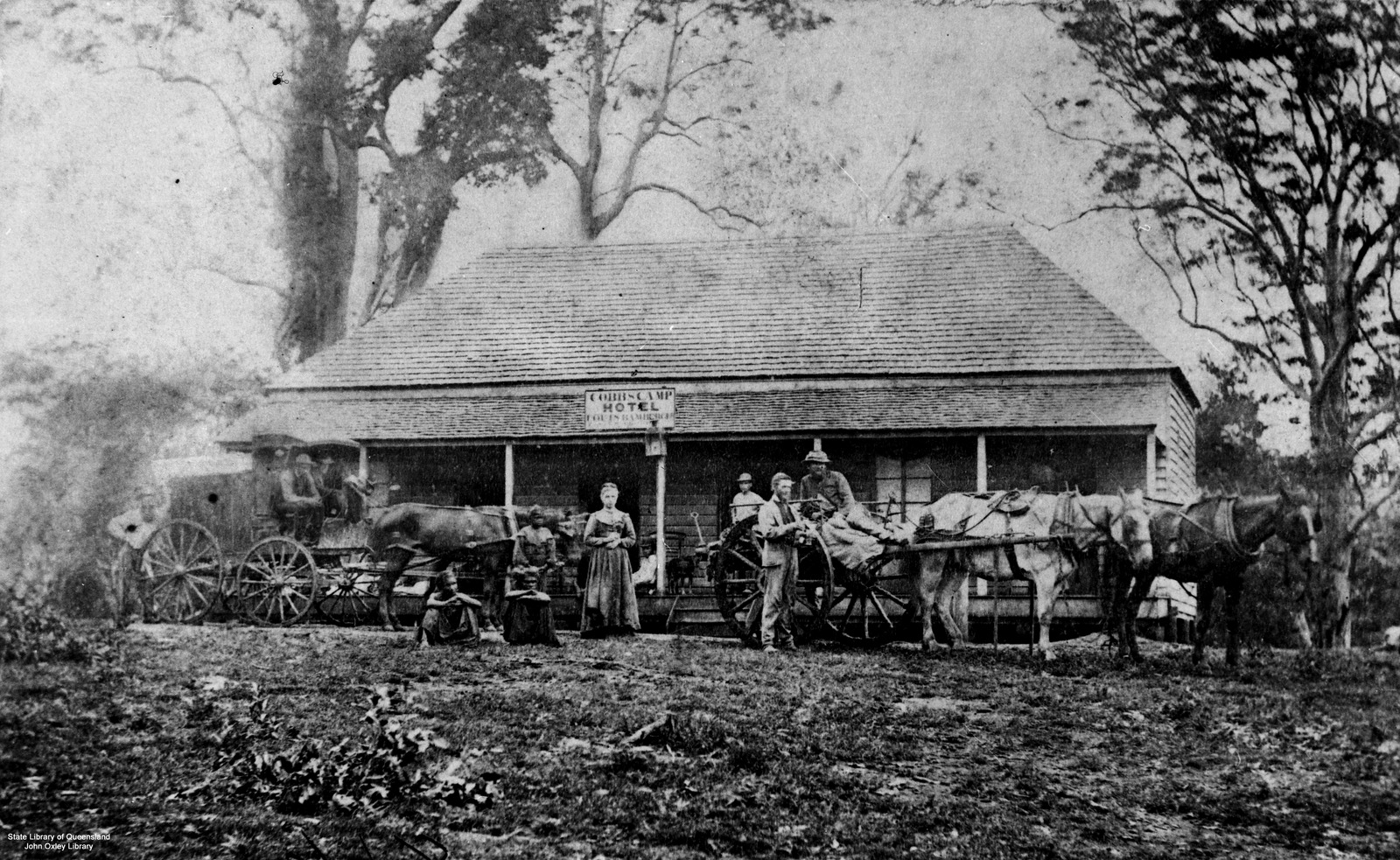
Cobb's Camp Hotel at Woombye, Queensland, ca. 1872. John Oxley Library, State Library of Queensland, Neg number 36278.
“Men, women and children, horses and carriages, in front of Cobb's Camp Hotel at Woombye, Queensland, around 1872. The hotel is a lowset weatherboard building, with a shingled roof and front verandah with all the doors of the rooms opening onto it. It was built by Cobb and Co for the overnight accommodation of passengers. At first the name Middle Camp was used, but it quickly became known as Cobb's Camp. The builders were Mewett & Son of Caboolture. The first passengers stayed at the hotel on 12 November 1868, and a liquor licence was granted to the keeper, James Costa, in 1870. (Information taken from: J. Tainton, Cobb's Camp, Woombye, 1977.)”
In 1868, William and Mary Grigor established a coaching station at Bankfoot House, in the Glasshouse Mountains. Some of the older buildings are still there today, and with a more recent homestead, are open to the public. The history of this house demonstrates the early pioneer life in the Sunshine Coast hinterland. Coaches and travellers were provided for at Bankfoot House, until the railway development on the Sunshine Coast in the 1890s took the mail contracts away and made the Cobb and Co coaches no longer viable. In 1874, in the annual report for Cobb and Co, it is reported that the following mail tender was successful - “Brisbane to Gympie, via Stewart's Ferry and Yandina, £1,800 p.a., increased to £1,980 p.a.”
Independent travellers were also able to stay at Bankfoot house, where a charge of one shilling was made for meals, one shilling for a bed and one shilling for a stable for the horses – three shillings in all – quite an expense when the working man’s wage was as little as 1 pound per week. When the bugle was sounded, Mary Grigor served the meals for the Cobb and Co passengers and the grooms prepared the horses.
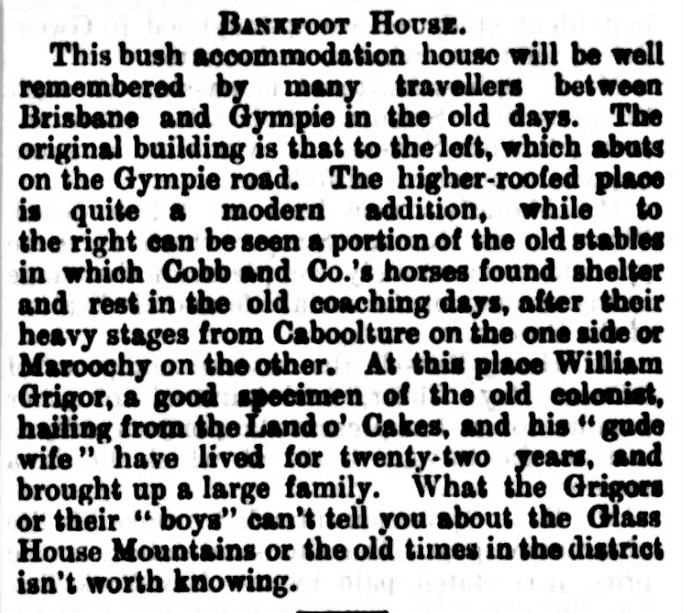
Bankfoot House. The Queenslander (Brisbane, Qld. : 1866 - 1939) 27 December 1890, p. 1210. Trove, National Library.
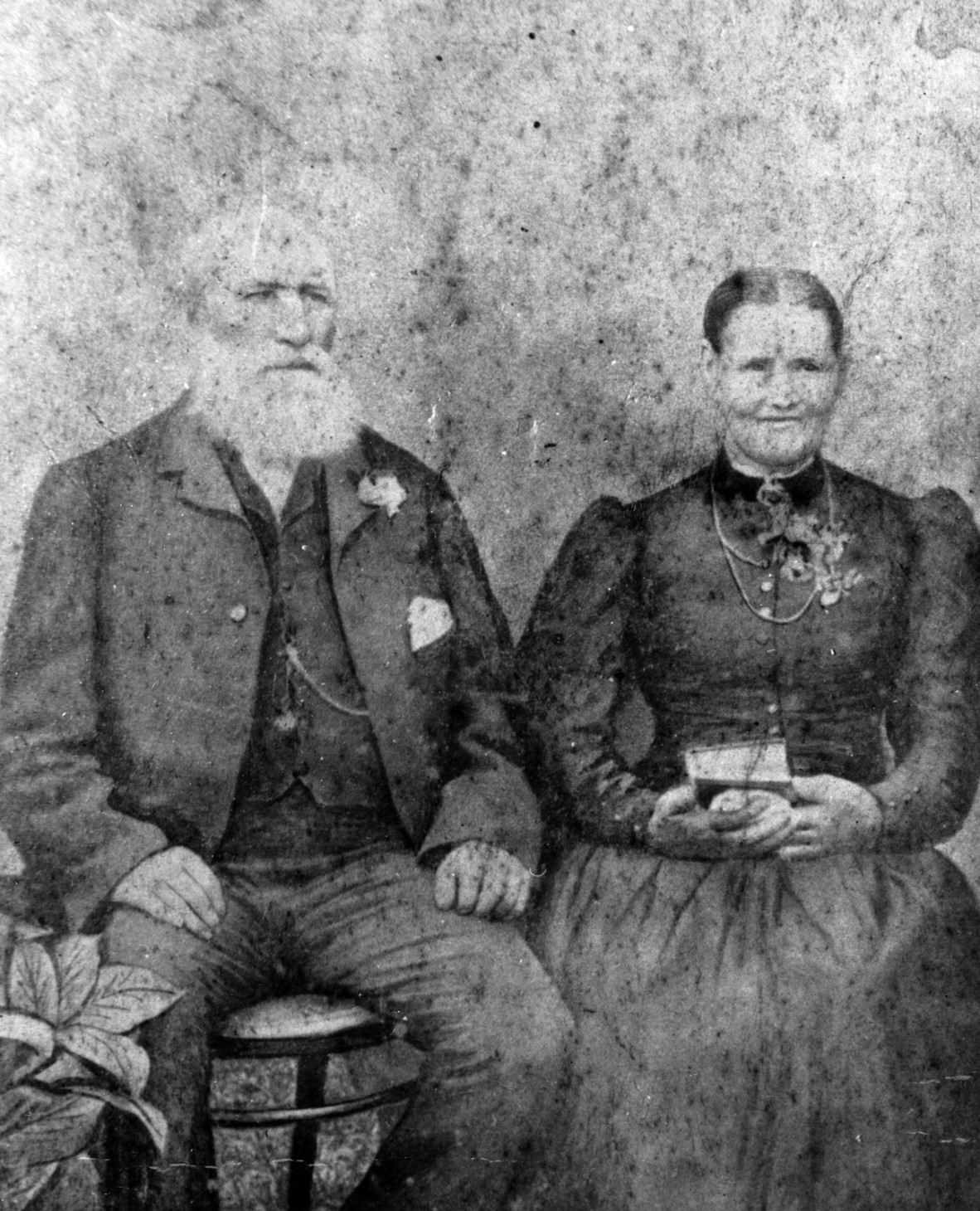
William and Mary Grigor and children at Bankfoot House, Glasshouse Mountains. John Oxley Library, State Library of Queensland, Neg. number 196159.
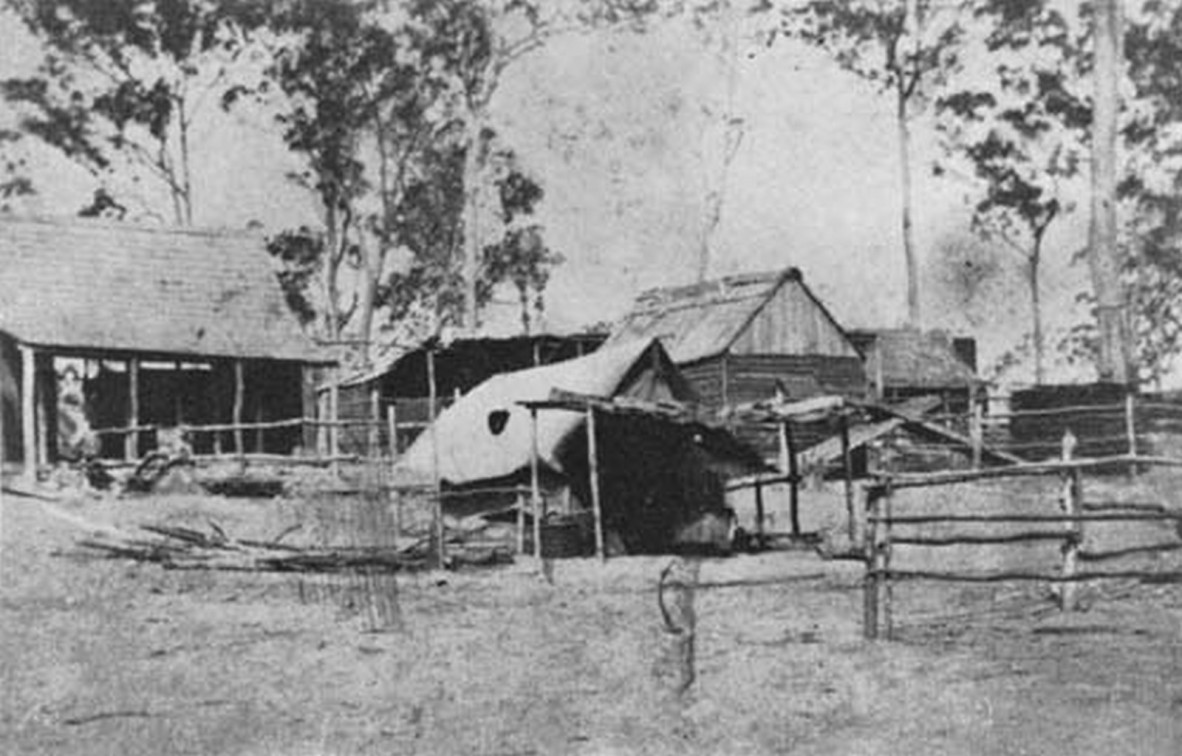
Cobb and Co's stables near the Northumberland Hotel, Gympie, ca 1870. Gympie Regional Libraries.
The journey from Brisbane to Gympie took 3 days in 1868, and the coaches travelled at a speed equivalent to 15 km per hour over the length of the run, a total of 117 and a half miles. The changing stations were listed in the Brisbane Courier on Saturday 28th November 1868
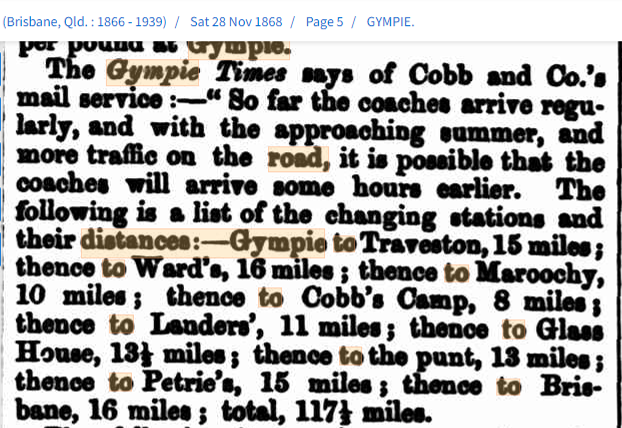
Gympie. The Queenslander (Brisbane, Qld. : 1866 - 1939) 28 November 1868, p. 5. Trove, National Library.
Not all of the journeys in those early years were successful. In January 1869, the coach was held up by two men who escaped with 25 pounds. One of the men, Mr W.Bond was captured and served 20 years in gaol for the crime. There were other coach robberies in the early gold mining days. In February 1869, a coach carrying mail and newspapers but no passengers was lost in the creek 9 miles south of the Maroochy River and the four horses were drowned. Fortunately, there were no passengers onboard. The mail and newspapers were retrieved from the creek but were reported to be “reduced to wet pulp.” An accident at Mooloolah in 1889, when the Cobb and Co coach was on its way to Caboolture was described in the newspaper, as was the injury to Mrs Bonney and her infant. Coach journeys were arduous and involved passengers alighting and walking where the terrain was difficult for the horses. The article mentions that:
All of the passengers with the exception of Mrs J.O.Bonney of Belle Park and Miss Tamlyn of Mount Ubi, got out to walk up the Mooloolah Range.
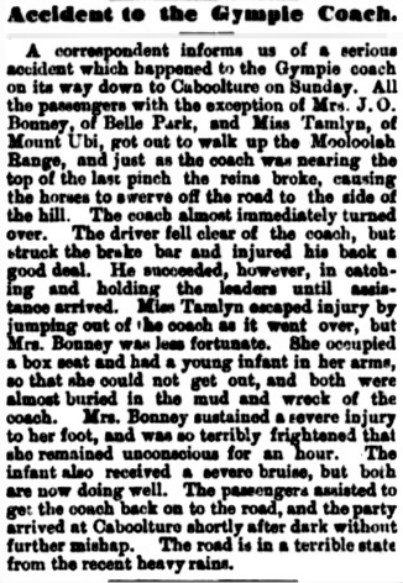
Accident to the Gympie Coach. The Queenslander (Brisbane, Qld. : 1866 - 1939) 27 April 1889, p. 775. Trove, National Library of Australia.
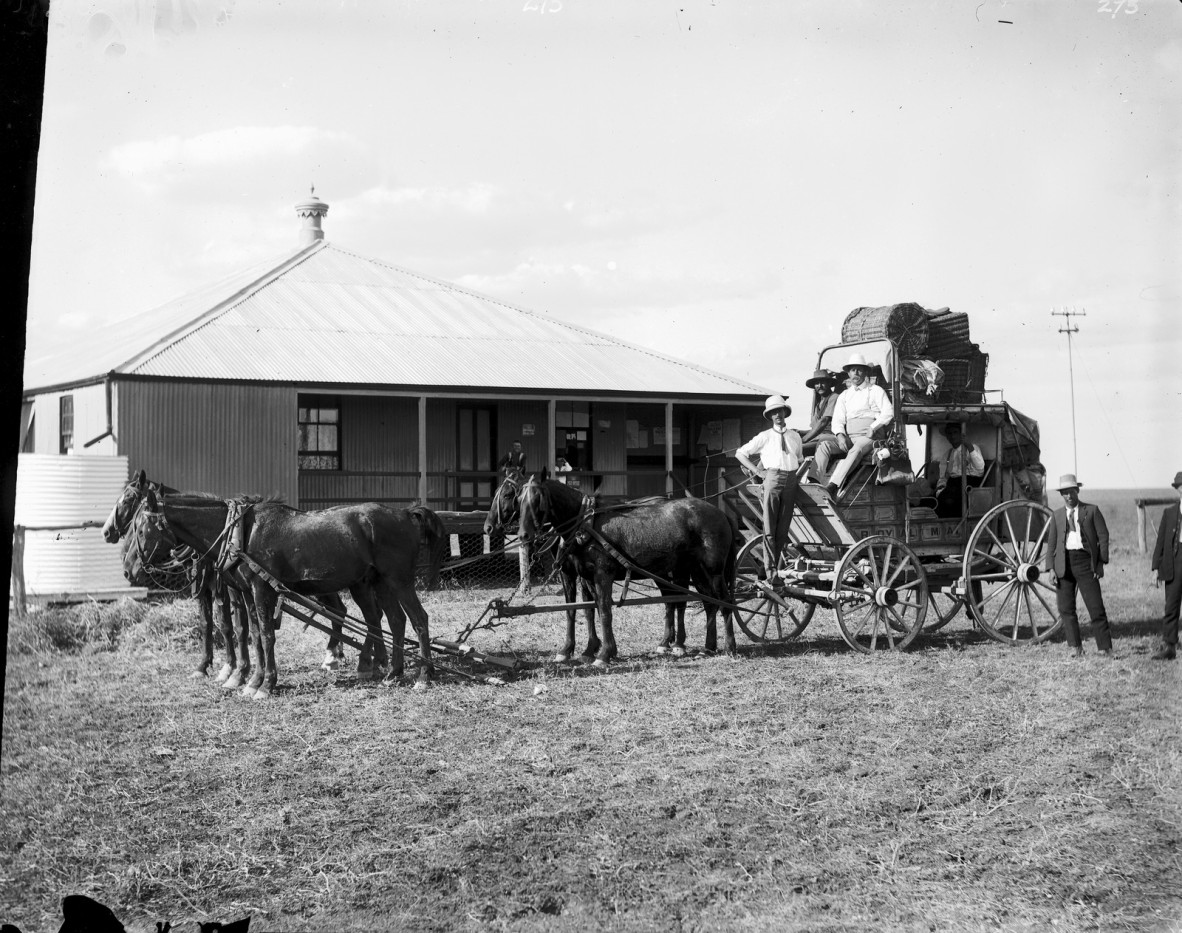
Royal Mail Coach in Queensland ca 1900. 30865 Barnard,13 Lawrence and Loane Family glass slides. John Oxley Library, State Library of Queensland.
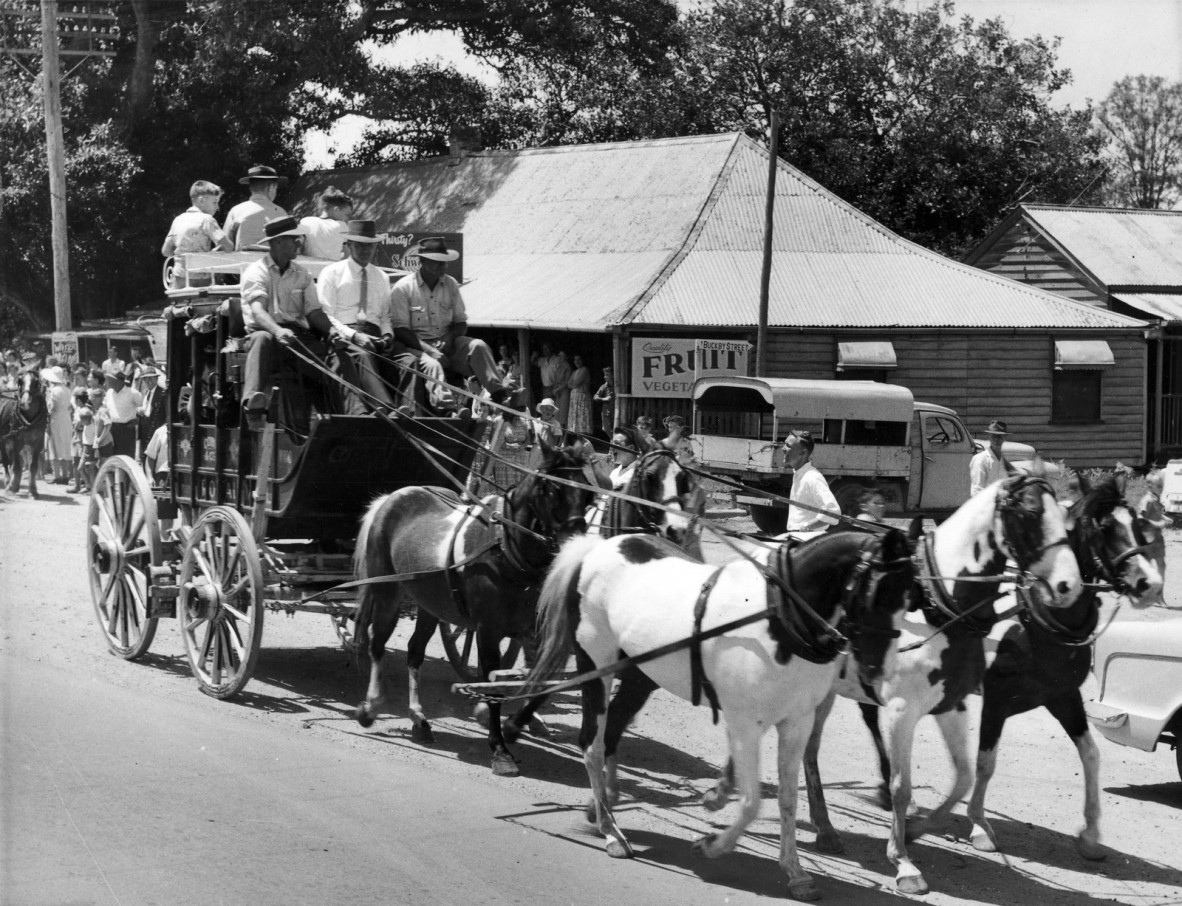
Replica Cobb & Co. coach with a load of passengers departing the original coaching station at Strathpine for Bald Hills, 7 November 1959. Caboolture Moreton Bay Regional Council.
In 1869, James Wallin built a large house with several outbuildings near the corner of Gympie Road and Buckby Street. As it was licensed as the Four Mile Creek Hotel from 1871 to 1877, it was the first hotel opened in the Pine Rivers area. The building continued to be used by coach drivers as a staging station when the North Pine River was flooded and coaches could not reach the hostelry in North Pine (Petrie). In 1879, the property was sold to George Buckby and it remained in the hands of his descendants until 1955.
Without doubt, the route from Brisbane to Gympie challenged the road builders, the coach builders, the government budget and the coach drivers. However, it was vital to making the growing regions accessible and attractive to miners and settlers alike. There were some other local coaching companies, such as McCallum’s Coaches that also ran on parts of the route between Brisbane and Gympie The last coaches on the Brisbane to Gympie route ran in the late 1890s and the last Cobb and Co Coach in the state ran in 1924 in Western Queensland. The North Coast railway line completed in 1891 had changed the landscape forever for the coaching companies and for travellers.
Christina Ealing-Godbold, Research Librarian, State Library of Queensland.
Further Reading
- Coaching in Australia : a history of the coaching firm of Cobb & Co. with guide to the present coaching routes in Queensland by William Lees. Carter-Watson Co., Brisbane, 1920.
- Cobb & Co. by Joan Edith Lorraine, Bathurst, 1996.
- Cobb & Co. by Margaret Jean. Hill of Content, Melbourne, 1972.
- Cobb & Co's catalogue of high class vehicles. Cobb & Co, Brisbane, 19--?
- The coachbuilder book of designs : comprising engravings of popular Australasian vehicles, with tables of measurements and other information. Axiom, Kent Town, SA, 1995.
- Bankfoot House : a journey through time. Friends of Bankfoot House, Glasshouse Mountains, 2013.
- Bankfoot House : 150 years on Old Gympie Road. Friends of Bankfoot House, Glasshouse Mountains, 2018.
- The coach & motor builder for Australia & New Zealand (journal). Bishop Brothers, Melbourne, 1917-1930.
- Cobb and Co Museum, Toowoomba. Queensland Museum.
Other Blogs
- Read other blogs about Cobb and Co.
Comments
Your email address will not be published.
We welcome relevant, respectful comments.